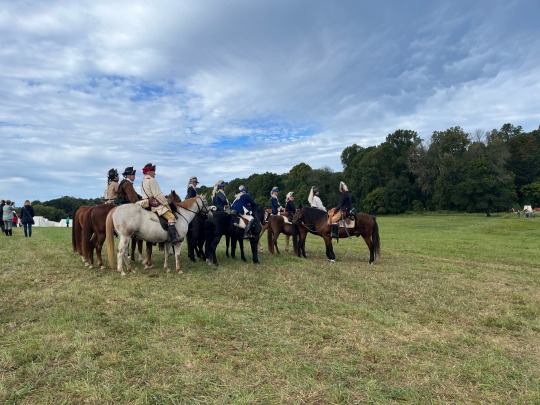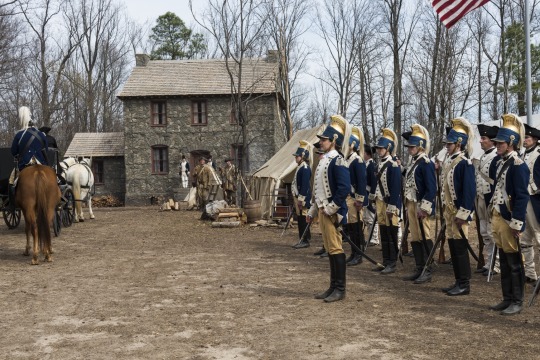#saber & shortgun
Text
Turn Week 2023:
History Nerdery!



Hello, and Happy Fourth of July! For today's Turn Week, I wanted to talk about Benjamin's regiment in the Continental Army. We all know he's a Connecticut Dragoon, but what does that mean and what did they do, exactly? I'm going to let you know! The Continental Cavalry is my favorite unit in the army, and I actually did an Honors Research Project on them last year for my college. WARNING: this is going to be LONG. I'm sorry. Kind of.
What is the Continental Cavalry?
The cavalry is the mounted troops in a military force, meaning they fight on horseback. At the time of the Revolution, the cavalry was considered an elite and necessary force for a proper military. Combat on horseback was dangerous- you not only had to avoid cannon and gunfire, but you had to attack other mounted troops with lances and sabers of their own.
There are two types of cavalry: light cavalry and heavy cavalry. The light cavalry had three primary duties. Scouting, which was to patrol enemy forces, movements, and the terrain surrounding camps and battlefields, which also played into reconnaissance. They also served as messengers to officers on and off the battlefield. On the other hand, heavy cavalry was troops used in action. Their objective was to lead charges and weaken the enemy’s unmounted troops, like going after their flanks. They also performed raids/ambushes or small skirmishes against the enemy. Their combat was on and off the battlefield.
Due to the near constant lack of funds for the Continentals, their Dragoons performed both light and heavy cavalry roles. A dragoon/trooper is a soldier who fights either on horseback or on foot, depending on the amount of horse available. They used weapons such as: a cavalry saber, a shortgun, and a musket.
Unlike the British army, which brought over cavalry forces, at the beginning of the war, there was not an official cavalry for the Continentals. Some state and organized militias had mounted troops- such as the Philadelphia Light Horse- but professional, commissioned troops had not seen action.
After seeing the performance of the British cavalry during the New York Campaign, General George Washington realized his army needed horses of their own. Writing to Congress in late 1776, “From the Experience I have had in this Campaign… I am Convinced there is no carrying on the War without them.”
What made up the Continental Cavalry?
In 1777, the cavalry's first year in action, there were four regiments of Light Dragoons.
The 1st Regiment of Dragoons- from Virginia, also known as Bland's Light Horse. Their uniforms were originally the "classic" Continental coat: blue with red facings, but they then changed the standard to brown with green facings.
The 2nd Regiment, also known as the Connecticut Light Dragoons, Colonel Elisha Sheldon and Benjamin Tallmadge's force, mustered from Connecticut, hence the name. Their uniform was blue with buff facings.
The 3rd Regiment, aka Colonel Baylor's or Lady Washington's Light Horse, in honor of Martha Washington. Their uniform was white with blue facings (one of my favorite uniforms in the army.)
And the 4th Regiment, led by Colonel Stephen Moylan. His troops originally wore red! coats, and this lead to some incidents of friendly fire. At Washington's order, the regiment changed to green with red facings.
How does this relate to Turn: Benjamin Tallmadge and His Dragoons.
Although the show does not get into heavy detail about Benjamin Tallmadge's battle experience, we know what battles he was present at with his regiment.
1777 the cavalry's first years as professional troops in battle. Both had very... different outcomes, let's say. Both were also mentioned or briefly shown in season 2 of Turn, and my research focused on this.
During the Campaigns, a set of troops from each regiment of Dragoons was stationed with General Washington in Pennsylvania, led by Bland, Moylan, Baylor, Sheldon, and Tallmadge.
Benjamin Tallmadge and his soldiers were present at both the Battles of Brandywine and Germantown.
At Brandywine, Washington first used the dragoons for only scouting, not combat. But as the British went after his insecure right flank, he frantically sent units of soldiers and cavalry to prevent the British from getting to the road along and to Brandywine Creek. The cavalry also acted as messengers to officers during this battle, but insufficient preparation and speed led to delayed reports. The cavalry did lead a charge that allowed Washington to retreat, but the day was lost. Afterwards, the British marched into the Continental capital of Philadelphia.
After Brandywine, Washington needed another battle to try and take back Philadelphia. With a night march, he decided to attack the British near their camp in Germantown, Pennsylvania, a small village outside the city.
Washington had four columns, 2 made up of Continental forces and two of state militias. Just as at Brandywine, his right wing was commanded by Sullivan, and his left by Greene. The Dragoons were now under their newly commissioned commander, General Pulaski. Tallmadge stated in his memoirs that, “if every division of the army had performed its allotted part, it seems as if we must have succeeded.”
Unfortunately, this would not be the outcome at Germantown. At the beginning of the battle, the Continentals were winning. Part of the camp was captured. A heavy fog and rain set over the battlefield, and the British used this fog to their advantage. They retreated into a local country house and created a stalemate.
Benjamin Tallmadge and his dragoons were first stationed with Sullivan’s division, close upon “the scene of the action.” As the battle turned against the Continental forces and the troops became victim to enemy and friendly fire, Washington ordered him to use his 2nd Dragoons to block any further retreat, to no avail. Germantown was lost.
Germantown was the last official engagement of the Philadelphia campaign. But on June 28, 1778, the Continental Army and the Cavalry engaged the forces at the Battle of Monmouth in New Jersey. Due to proper military training thanks to the Inspector General Baron von Steuben and six months of waiting at Valley Forge, the army emerged as a proper fighting force and prevailed against the British. The victory allowed the Continentals to take back their capital and keep Washington in as Commander in Chief.
Monmouth is the shown in the finale of season 2- Gunpowder, Treason, and Plot- with Benjamin leading his dragoons into the battle.
After the 1777 campaigns, Tallmadge and his dragoons would stay up north, particularly New York, to patrol and engage the enemy in raids. They also participated in the Battles of Stony Point and Fort St. George, which were shown in seasons 3 and 4 of Turn.
Sources (and further reading):
Memoir of Col. Benjamin Tallmadge : Tallmadge, Benjamin, 1754-1835 : Free Download, Borrow, and Streaming : Internet Archive
Brandywine: A Military History of the Battle that Lost Philadelphia but Saved America, September 11, 1777 by Michael C. Harris, Paperback | Barnes & Noble® (barnesandnoble.com)
Germantown: A Military History of the Battle for Philadelphia, October 4, 1777 by Michael C. Harris, Hardcover | Barnes & Noble® (barnesandnoble.com)
Cavalry of the American Revolution - Jim Piecuch - Westholme Publishing
#oh my GOD#i went insane#i went crazy#i'm so so sorry#i just really really like dragoons.#turn week 2023#turn: washington's spies#benjamin tallmadge#military history#american revolution#the Philadelphia campaign#saber & shortgun#I hope I got everything right. oh my god. I’m sorry.#long post
128 notes
·
View notes